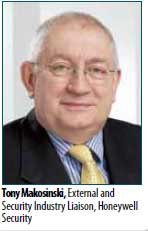SPICING UP OLD FENCES
Perimeter security and intrusion detection products are more complex and powerful than ever. End-user behavior has also shifted from using individual products to combining various detectors and sensors for holistic protection. “As a result of the fact that basic detection technology has been getting better and more advanced, the coverage of different risks is currently much better than some years ago,” said Juergen Grasmehr, Global Portfolio Manager Intrusion and Perimeter Systems, Siemens Building Technologies.
“It is now possible to cover almost any kind of areas or objects, such as fences, walls, ground, water, air, building roofs and building facades. Together with other technologies like video surveillance, it is now possible to have very high detection quality combined with an automatic, sophisticated verification thanks to automatic camera tracking, zooming, object classification, visualization in overview maps and the like.”
One way to provide greater security at critical infrastructure sites is to combine multiple security technologies. “Indoor detection systems can be expanded with perimeter protection for advanced warning, while multiple technologies can be combined in the perimeter protection, such as fence and active IR; fence and microwave; motion and video surveillance; or combinations of these,” Joosens said. “Improved anti-masking technology reports sabotage attempts to the security system, and finally the increased use of video surveillance cameras with higher image quality and longer range provides better security at key sites.”
IR with microwave, quad pyro elements, multicurtain laser and 3-D detection based on time-of-flight technology are some examples of basic detection technology becoming more advanced, Grasmehr said. “Also, detector information can be delivered faster and more precisely with current technology. For instance, placing a number of alarms in a specific zone from different detectors can increase or decrease the real alarm probability.”
For outdoor detectors , the increased development quality, as well as manufacturing quality of electronics and mechanics, is manifested in affordable high-end products such as laser scanners, radar detectors, high-end fiber optical detection systems or piezo dynamic sensors, Grasmehr said. “New sensor systems are more flexible, and in some it is possible to run and combine multiple, complex detection algorithms on one detector at the same time. For instance, a laser scanner is able to detect small object in one area and large object in another area.” Dual motion sensing technologies — such as double passive infrared (PIR) or PIR with microwave — are also gaining popularity, as combinations are capable of achieving higher false alarm immunity, Joosens said. 
“Using the latest K-band dual technology, this kind of sensor verifies the PIR signals with the microwave signal prior to any alarm decision and is less likely to trigger false alarms as K-band microwaves do not penetrate walls and glass as easily,” explained Tony Makosinski, External and Security Industry Liaison, Honeywell Security.
“Therefore, faster and more reliable detection is achieved, and false alarms and associated intervention costs are reduced. As this technology becomes more developed, it is increasingly taken up by the rest of the industry.”
For fences, cable sensors deploying fiber optics and coax are prevalent today, said Curtiss. “For fences with detectors, PIR detectors offer superior performance when complemented with a perimeter security system in areas such as gates, roads or any location that may require trenching.”
Buried fiber-optic systems appear to be taking the lead versus radio frequency/leaky coaxial types of sensors in underground detection due to their immunity to water, lighting and soil conditions, said David Smith, CEO of Optellios. 
“Although fiber optic technology is not new, the prevalence of its use in security deployments is on the rise compared to strain gauge, microphonic and shaker systems, because it is easy to install.” Fiber requires no electronics on the fence, no additional power and is immune to lightning and radio interference. It has sufficient bandwidth to handle video and access control communication. Detection technologies initially developed for military applications, such as radar detection, are more common in civil security projects, Grasmehr added. “The radar system could detect and track a person from a considerable distance before he or she is even near the fence or up to the fence line, and continues to track once the person has entered the fenced perimeter,” said Jason Burger, Sales and Marketing Manager, Navtech Radar. “Radar does not require light or good weather to function, and would work in all light and weather conditions.”
“Some airports are using radar arrays that are configured to detect movement in both the X and Y axes. This data is then combined to produce a 3-D display of the target,” Curtiss said.